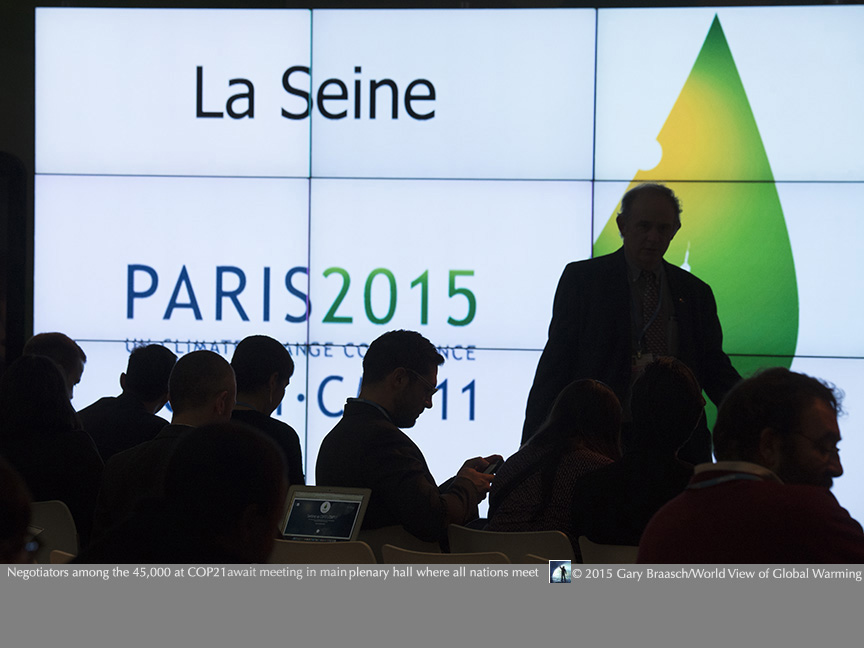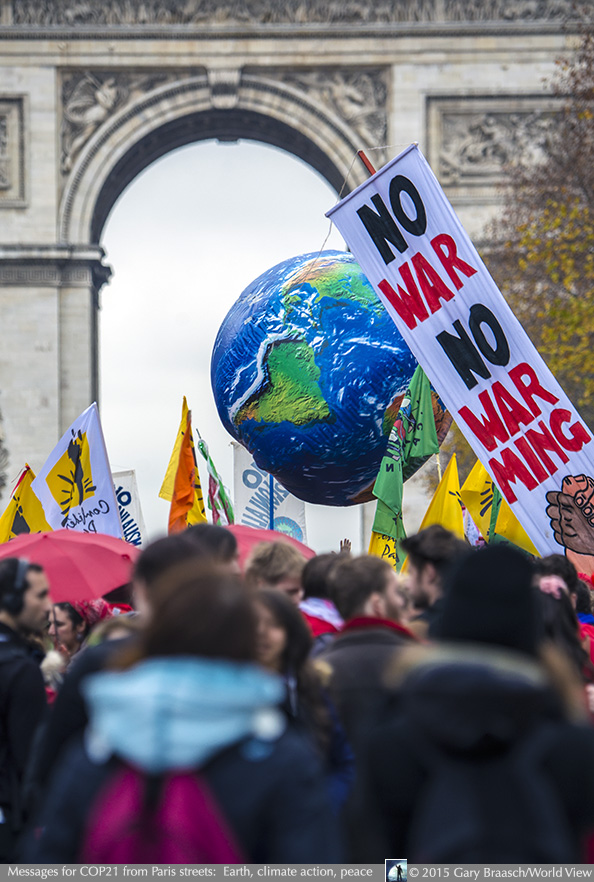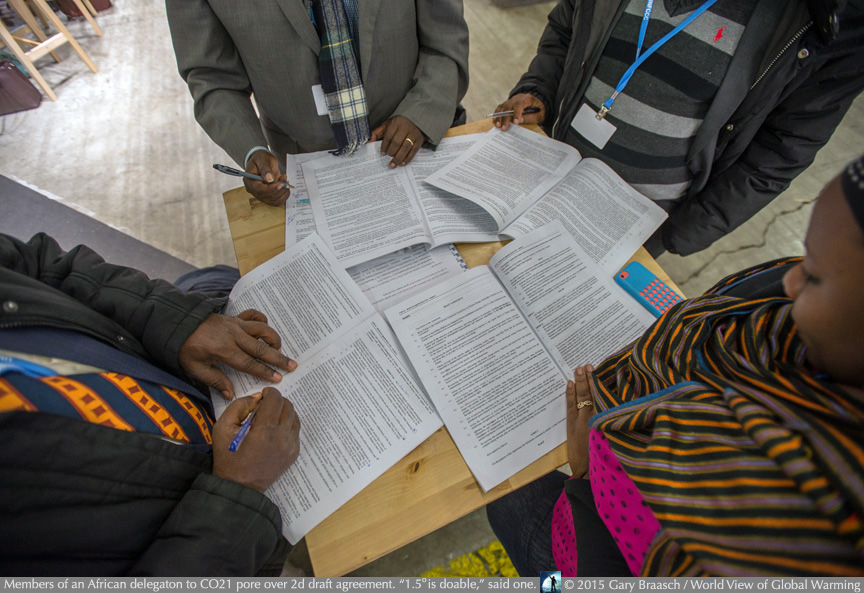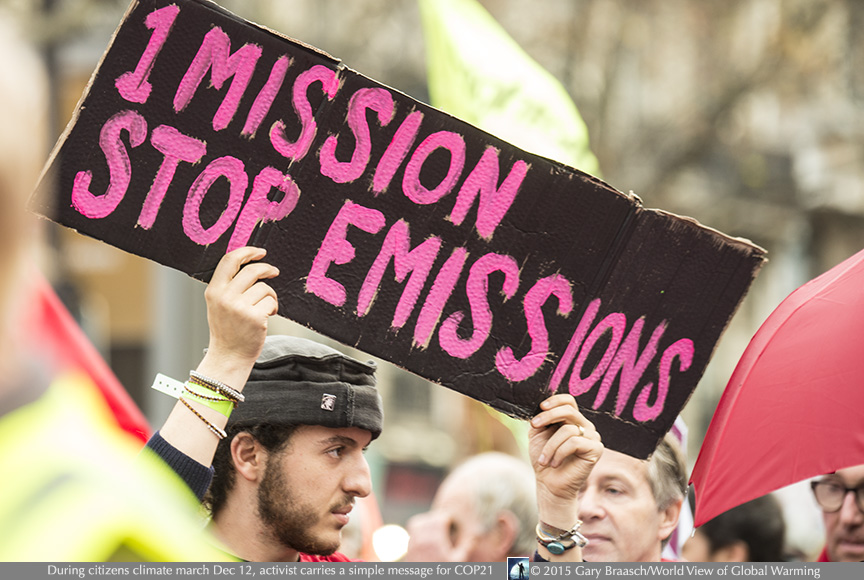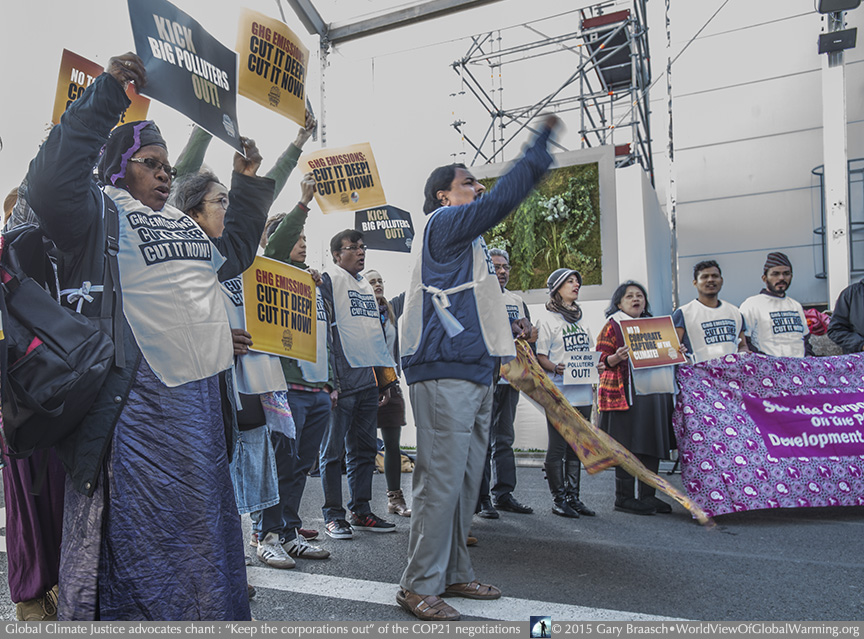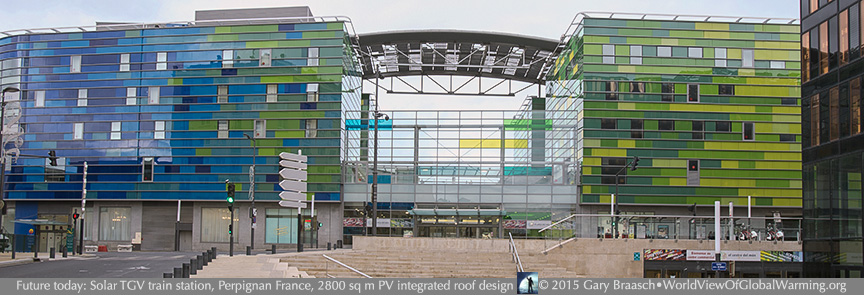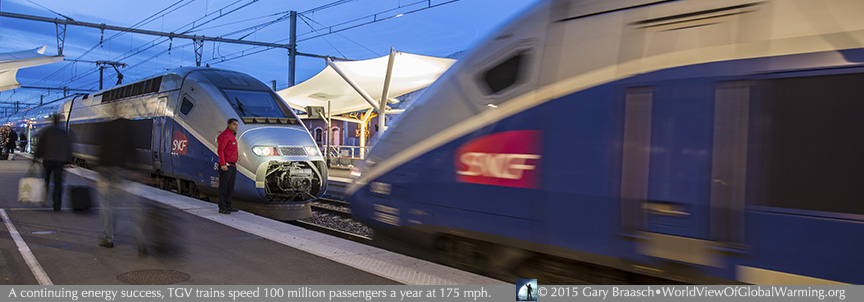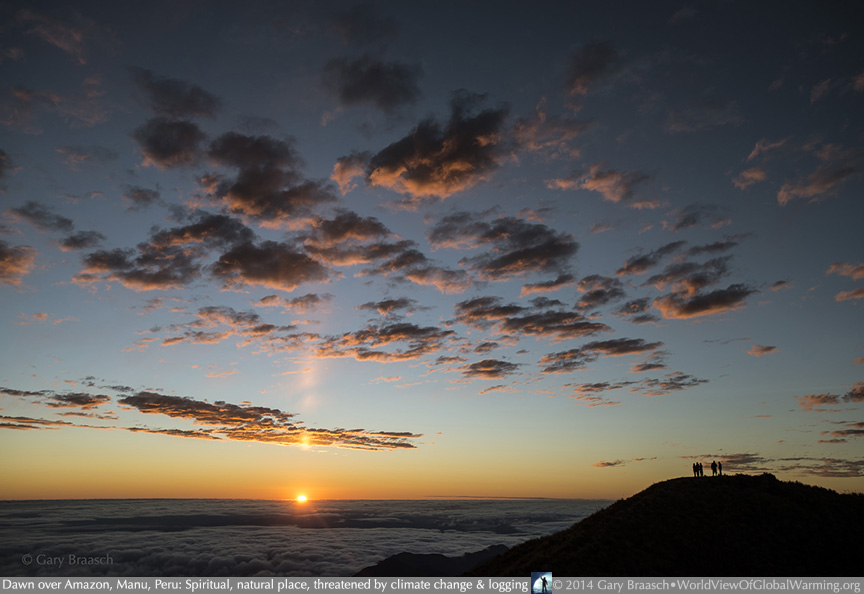COP21 Photos 8 | 7 | 6 | 5 | 4 | 3 | 2 | 1
COP21, UN climate negotiations, Paris, Nov-Dec 2015
COP21, the Paris Climate Talks, December 4, 2015
COP21, the Paris Climate Talks, December 8, 2015
COP21, the Paris Climate Talks, December 9, 2015
COP21, the Paris Climate Talks, December 12, 2015
COP21, the Paris Climate Talks, December 13, 2015
“The Force Awakens” -- ten days ago on our planet, in the Paris climate agreement at COP21. Making this Force powerful is the central work of the 21st century for nations, corporations and society.
A perspective from 16 years of documenting climate science, effects and solutions. 22 December 2015
In these Holiday weeks as millions stream into theaters to watch the new episode of Star Wars, set “a long time ago in a galaxy far, far away,” we can reflect on what happened about 10 days ago on our planet.
In the intense moment December 12 when the Paris Agreement was reached, I felt privileged as witness and participant in the great climate education and action movement. Finally what I envisioned in 2007, that “the world’s nations will recognize in global warming a common danger to their people, their cultures, and the Earth that supports them all,” is taking form an international agreement.
The UN Framework Convention on Climate Change of 1992 (UNFCCC) now has an action blueprint for limiting global warming by cutting greenhouse emissions and adapting to climate changes. The Agreement is imperfect and not urgent enough, but with the many agencies, companies, groups and individuals already engaged about climate, a planetary force is awakening to deal with this issue that affects us all.
The Paris Agreement is a great achievement. For the first time a treaty-strength agreement of 195 nations “aims to strengthen the global response to the threat of climate change…by holding the increase in in the global average temperature to well below 2 degrees C above pre-industrial levels and to pursue efforts” to limit to 1.5 degrees. It will be seen in the future as the moment when the world turned away from fossil fuels and recognized the inequalities of their use since the industrial revolution began.
The agreement’s weaknesses are that it lacks binding emissions plans to reach the 2 degree limit, firm levels and dates for emission reductions, secure funding to aid less developed nations and mechanisms to insure that countries do what they’ve promised. It will work only if the powers that control our energy and policy seize the moment to follow and improve the agreement, and world citizens remain vigilant and demand that they do, with loud voices, community, municipal and corporate participation and votes. Action must begin now and intensify in the coming few decades.
In a longer perspective, from my experience documenting and writing about global warming and climate change for more than 15 years I am disappointed that what was scientifically and physically evident years ago has taken so long to reach a more general consciousness, politically and industrially. Much more damage has been done and time is very short for effective action – but act we must with renewed determination. The 20-year refusal by most nations to stabilize CO2 levels by adopting emission controls as they agreed in the UNFCCC must end.
The climate agreement – and the presence at the COP of so many citizens from developing states and those who have felt the power of climate change directly – reflects our growing knowledge of how interconnected climate and energy are with the way we live on personal and community levels. Climate and energy are central to our food supply and health, our work, the way we govern ourselves, and the way we relate to one another as nations and cultures. Basic human values are affected by the way we get and use energy—ideals and rights like family, nature and creation, security, access and purity of food and water, freedom, equality, and independence. The Paris Agreement reflects, though does not fully respond to, the global ethical responsibility and empathy for human suffering.
From Paris we begin to sever the world’s deep dependency on fossil fuels, which came about because coal and petroleum are strong sources of energy from the ancient Earth—powerful, portable, and plentiful. Coal fueled the Industrial Revolution and still produces 40 percent of the world’s electricity. The process of distilling petroleum was invented only about 150 years ago. Since World War II we have refined and reformulated petroleum to produce fuels, fertilizers, and plastics—and with them and coal power we’ve created the modern world.
The cost of extracting, using and abusing these fuels has been immense, and along with the associated rise in world population has come environmental change ten times or more rapid than in prehistory. Now, primarily due to the greenhouse gases from fossil fuels and human land use, unnatural climate change is a decisive, overarching event of the twenty-first century. It only compares with war in its traumatic effect on people, cultures, ecosystems, and species. Climate change-worsened droughts and crop failures have been linked to war in the Mideast. Since 2008, according to research featured at COP21, more than 22 million people a year have been displaced by the impacts of floods, storms, seacoast inundation and other weather events which climate change makes worse.
We are changing the climate. This is a powerful truth, considering climate’s controlling role in creating the habitat of every living thing and its influence over the course of human events.
As we increasingly see the harmful results of energy and landscape management decisions, we must also see that different choices can create change in the opposite direction. Every level of community, business, national governance, and international relations must be involved in this – thus was born the UN climate convention of 1992 and its yearly meetings, the Conference of the Parties (COP), with the COP21 held in Paris this month.
The convention’s objective is “to achieve stabilization of greenhouse gas concentrations in the atmosphere at a low enough level to prevent dangerous anthropogenic interference with the climate system. Such a level should be achieved within a time-frame sufficient to allow ecosystems to adapt naturally to climate change, to ensure that food production is not threatened and to enable economic development to proceed in a sustainable manner.” Thus, Article 2 of the new Paris Agreement states the goal of below 2 degrees C above pre-industrial as a stabilization point agreed on by many scientists. It aspires to a 1.5 degree limit which many other experts say is needed. Already at one degree C higher there is climate-driven disruption, displacement and death.
Notably, the 1992 convention’s article 4 on “Commitments” says, “Each of [the developed nations] shall adopt national policies and take corresponding measures on the mitigation of climate change, by limiting its anthropogenic emissions of greenhouse gases.”
The great failure of the nations who signed this treaty in the 1990s, including the great polluters the United States, EU, China, and coal and oil nations – the great tragedy and some would say crime – is that lack of an agreed international process for limiting greenhouse gases not only was used as an excuse for national inaction by many nations, but was actively perpetuated through 20 meetings of the parties to the convention. Despite the incomplete Kyoto Protocol involving 43 nations, yearly world carbon emissions are 60 percent higher now than in 1990, and CO2 in the atmosphere has risen from 352 ppm to over 400. Only economic downturns have created dips in these upward curves.
Meantime, rising up along with the huge damage and intensified carbon pollution of the atmosphere, was a worldwide citizens movement.. Originally informed by the great conservation NGOs and energized by local events and the spread of climate news across the internet, thousands of groups now lobby politicians, prod businesses, and engage their fellow citizens everywhere. This grassroots is building the soil in which real change can root and grow, within and outside of the new Paris Agreement. The world cannot afford more inaction hiding behind the legal finepoints of shoulds and shalls in the text, nor the wrangling over who must act first.
Society is moving to defend its values, the values that guide our personal and communal lives, which are jeopardized by continued carbon emissions and climate change:
National security is weakened by climate change – a force multiplier of other dangers like war, terrorism, isolationism, and economic vulnerability.
Self-sufficiency of communities and many nations diminishes with dependence on oil and coal as primary fuels, and on the multi-national corporations which control them.
Burning the vast coal and oil reserves poisons our climate and our health.
Good government at all levels is being corrupted, potentially great leaders are discouraged, higher value national needs are ignored.
Ethical values of justice, morality, and righteousness are violated. The effects of climate change are distributed very unfairly, as are the profits and costs of energy extraction and use. Honoring God’s gifts and treating others as the children of God are central tenets of religion but are often betrayed by priorities driven by narrow economic needs.
From fossil to future is the goal for the world: to still enjoy abundant energy but to get it from much less polluting sources which reduce carbon emissions to near zero by 2050 or shortly thereafter, and distribute it fairly to all of humanity. Still today, while 80 percent of world energy is still from fossil fuels, 1.3 billion people have no electricity and almost three billion live in households with polluting biomass (wood, dung) or coal cookstoves.
Meanwhile, huge resources in solar, wind, hydro and biologic energy, and huge potential savings from greater energy efficiency, although growing, remain underused and underfunded. Total fossil fuel subsidies are four times those for renewables. The promise here lies in the sun’s energy, which each hour strikes the Earth with more power than humans use in a year. This immense flow drives the weather, the wind, plant growth, and the water cycle. We need to engage all kinds of this energy, selected through policies which place strong limits on greenhouse gas emissions; provide a level economic and legal playing field for all energy sources, purveyors, and users; and create an open marketplace in which carbon pollution has a price and safety, siting, and accessibility are important concerns.
The benefits of making this change are immense, and the goals are worthy in their own right. Success requires dedicated and bold leadership, from the public and private sectors, nationally and worldwide, across a broad political spectrum and throughout society.
The world must shake off the chains of fossil fuels, the very power that brought civilization to this point of progress and peril, even though we are mostly dependent on them for our most basic needs—working, putting food on our tables, and housing our families. The science of global change, the economics of energy, and the finite reality of the resources of the Earth say it can’t continue. What comes next with unchecked climate change could be profoundly negative, rendering hollow the promises of life, human rights, and peace that we hold out to our children and the rest of the world.
What should be the vision for our future? A better direction would emphasize stronger communities, better home life, cleaner air and water, less-expensive utilities, expanded local businesses, widespread good health, universal education, human rights, population limitations and international cooperation, and a planet that can support all of us.
In my book Earth Under Fire: How Global Warming is Changing the World, I said that to fuel this revolution, no policy should be promulgated, no program initiated, no alliance sealed, no purchase made, no machine designed or built, no land use permitted, no product introduced, no law passed, no politician elected, unless the action is a step forward to reduction and reversal of the effect of excess greenhouse gases.
The world has taken a grand step toward this transformation in the Paris Agreement on climate change. We all now must be the force and create this change -- at the ballot box, in boardrooms, in citizens’ assemblies, and in the marketplace.
May the Force be with us all.
Gary Braasch
… with Joan Rothlein
Our running coverage of COP21 is available at Paris News
Many new photos of the COP scene and outside citizens actions begin here.
Update on the energy revolution is available here.
This project would be impossible without scientists and observers around the world who have provided hundreds of scientific contacts and papers. See Background, Advisors, and Reference for documentation, funders and major advisors, without whom I could not complete the work.
World View of Global Warming is a project of the Blue Earth Alliance, Seattle Washington, a 501(c)3 tax-exempt organization. The project is supported entirely by donations, grants, and license fees for the photographs. Please see information about how to contribute.
For other information about Gary Braasch's climate change projects and books, please see the books Earth Under Fire and How We Know What We Know About Our Changing Climate, and the exhibit "Climate Change in Our World" at the Books and Exhibits link on the top menu of this page.
COPYRIGHT NOTICE:
Photography and text Copyright © 2005 - 2017 (and before) Gary Braasch All rights reserved. Use of photographs in any manner without permission is prohibited by US copyright law. Photography is available for license to publications and other uses. Please contact requestinformation@worldviewofglobalwarming.org. View more of Gary Braasch's photography here.



